Europe’s World Heritage Sites
In 1972 UNESCO established World Heritage Sites in order to preserve and protect some of humanity’s most significant cultural achievements and the globe’s greatest natural landmarks.
Europe has many UNESCO World Heritage sites, reflecting the fascinating history, spectacular architecture and breathtaking landscapes of the continent. To get you inspired for your next trip across the Channel, we’ve put together a list of some of the most beautiful and enchanting World Heritage sites in France and the countries closest to our Calais terminal.
What are UNESCO World Heritage Sites?
UNESCO World Heritage Sites are legally protected by international convention, which ensures that they are not at risk from destruction, development or damage, and have indefinite rights for conservation. Sites are classified as cultural, natural or mixed properties.
France
How many heritage sites are there in France?
There are 49 World Heritage Sites in France – 42 cultural properties, 6 natural and 1 mixed property. These are just a handful:
Grotte Chauvet-Pont d’Arc, Ardèche
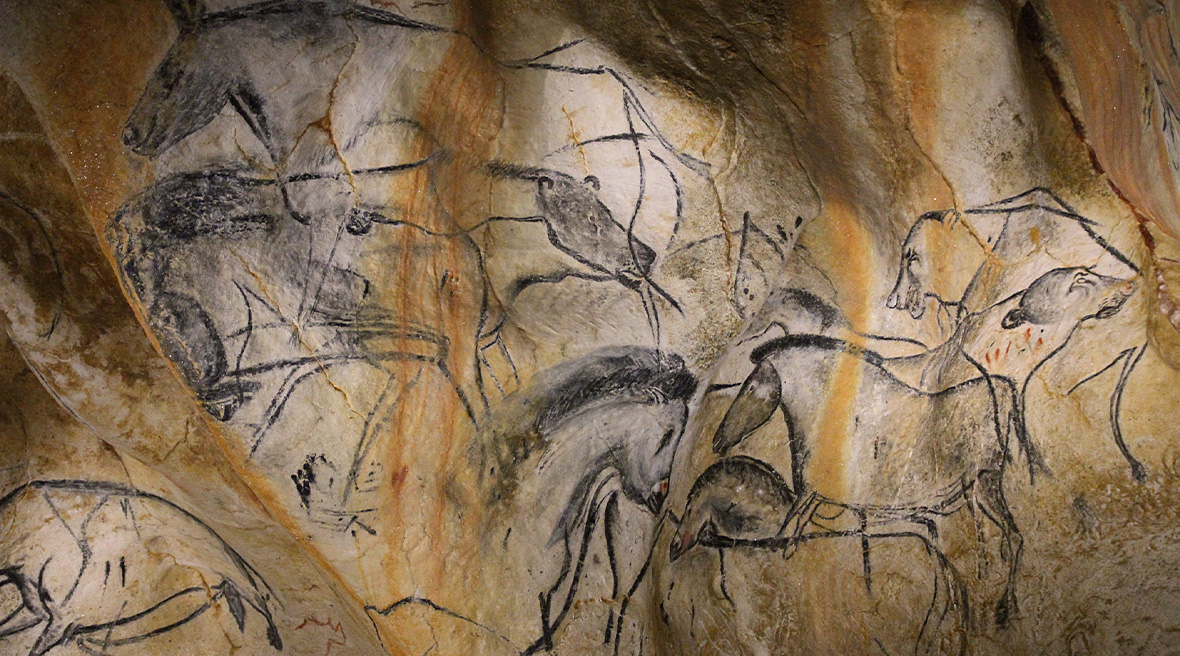
Credit: Horse Panel (right), by Claude Valette, CC BY-SA 4.0, via Wikimedia Commons
The incredible cave drawings of Grotte Chauvet-Pont d’Arc
The Chauvet-Pont-d’Arc cave is home to some of the earliest known and best-preserved cave paintings in the world, dating back an astonishing 32,000 years.
Discovered in 1994 on a limestone cliff above the old riverbed of the Ardéche River in the Auvergne-Rhône-Alpes region, the cave contains paintings of around 13 species of animals, as well as baby hand prints, which are said to be from a later period. Intricate portraits of horses, bears and panthers cover the walls of this enchanting place of history.
As a way of preserving the site and protecting it from damage, the caves are no longer accessible to tourists. But an exact replica of the cave, based on 700 hours of laser scanning, opened to the public in April 2015.
Roman Theatre and its surroundings and the "Triumphal Arch" of Orange
Only around an hour and 15 minutes drive from Grotte Chauvet-Pont d’Arc is perhaps the most complete ancient Roman theatre in Europe.
The Théâtre Antique d’Orange near Avignon is an amazingly well preserved example of 1st-century Roman architecture. As well as the theatre, you can also explore the Triumphal Arch and the remains of the onsite temple, which was excavated in the 1920s.
After exploring each of the buildings, make your way to the Orange Museum, where collections of ancient art, sculptures, mosaics and pottery are on display. Or pay a visit to the theatre during the summer, where the famous opera festival, Chorégies d’Orange, is held.
Provins, Town of Medieval Fairs
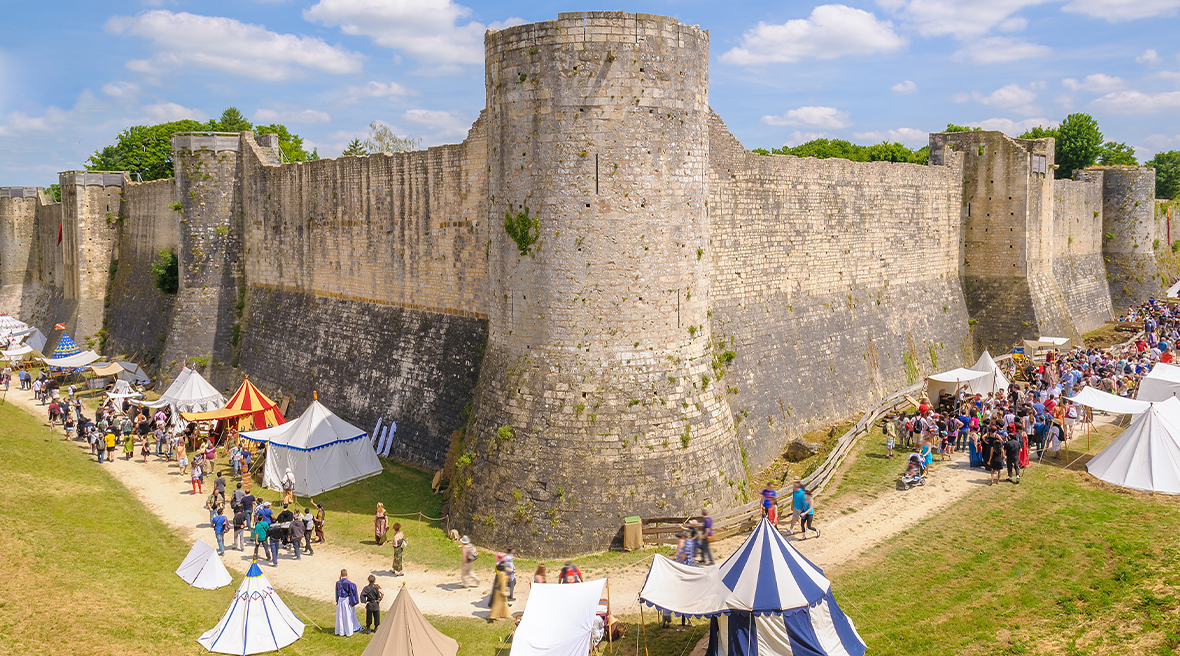
The fortified walls of Provins
The Île de France town of Provins has a unique importance because it is the only surviving example of a medieval town that held agricultural and trade fairs in the Champagne region in the High Middle Ages. Its architectural heritage reflects the growing cultural and mercantile connections that existed in Europe at this time.
The best preserved parts of Provins are its ramparts and fortified gates, Cesar Tower and Tithe Barn, a vaulted stone building with low ceilings that has been made to look as it was in the 13th century when it was occupied by merchants from Toulouse.
Amiens Cathedral
One of the closest World Heritage Sites to our Calais terminal, Amiens Cathedral has been on the UNESCO list since 1981.
It is simply a monumental building – the largest cathedral in France (big enough to fit two Paris Notre Dames inside). It only took 50 years to complete in the 13th century, a ridiculously short time frame for a medieval building of such scale, and this is what probably accounts for its great unity of style. The sculptures on its west façade and south transept portal are among the finest in the Gothic tradition.
Canal du Midi
Constructed in the 17th century, the Canal du Midi is considered one of the great engineering works of its time. It realised a long held dream for the French monarchy, of opening up a continuous waterway from the Atlantic Ocean to the Mediterranean Sea.
Its designer, Pierre Paul Riquet, overcame numerous engineering challenges, most notably how to take water up the valley from Toulouse to Seuil de Naurouze, the highest point of the canal. Among Riquet’s other feats was to build the world’s first canal tunnel at Malpas. The Canal du Midi is thriving today for leisure traffic, and is still an important source of agricultural irrigation. Why not take a 7-day cruise on the canal?
The Netherlands
How many heritage sites are there in the Netherlands?
There are 12 UNESCO World Heritage Sites in the Netherlands.
Mill Network at Kinderdijk-Elshout
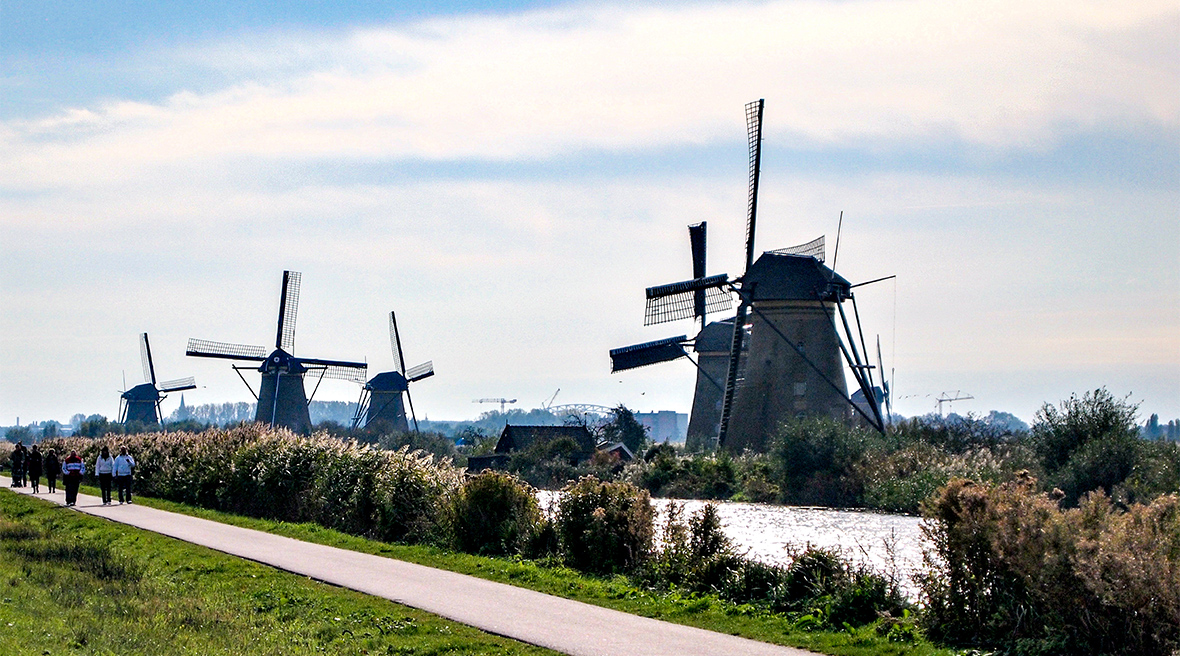
The windmills of Kinderdijk-Elshout helped make the land fit for settlement and farming
For a taste of Dutch culture and its past, enjoy a day out at the Mill Network in the village of Kinderdijk. Built in the Middle Ages, the 19 windmills of Kinderdijk were constructed to drain the Alblasserwaard polder, which is connected to the Lek and Noord Rivers. Despite being built so long ago, the windmills still work today as successful hydraulic structures.
During your visit, you’ll be able to explore the mills for yourself, and even learn about their history in greater depth at the museum. There’s also the chance to take part in a windmill workshop, where you’ll learn how the mills were built and maintained, and even how to become a miller.
Wadden Sea
The Wadden Sea is a 310 mile stretch of intertidal sand and mud flats stretching across the coastline of the Netherlands, Germany and Denmark. It was given UNESCO status because of its huge importance as a breeding ground for birds, for its flora and fauna and for its high levels of biodiversity.
It is a rich habitat for a wide range of species of birds, fish and mammals. Grey seals, heron, Atlantic salmon and dolphins are all common visitors, and the only natural remaining population of houting, a species of fish once thought extinct, survives in the Wadden Sea.
Rietveld Schröderhuis
The Rietveld Schröderhuis in Utrecht is perhaps the finest example of Dutch modernist architecture. The house was built in 1924 by the architect Gerrit Rietveld for Mrs Truus Schröder-Schräder, his lover and long-time collaborator. She held progressive views on personal relationships and architecture and wanted her house to reflect this. It stands at the end of a traditional terrace of houses, which adds to its boldness.
While not without internal walls, the house has an open plan design and its upper floor is a large open space with sliding panels instead of walls. The rectangular planes and lines and the colour patterns give the house the feel of a Mondrian painting. It is now a museum and is open to the public.
Belgium
How many heritage sites are there in Belgium?
There are 15 UNESCO World Heritage Sites in Belgium.
Historic Centre of Bruges
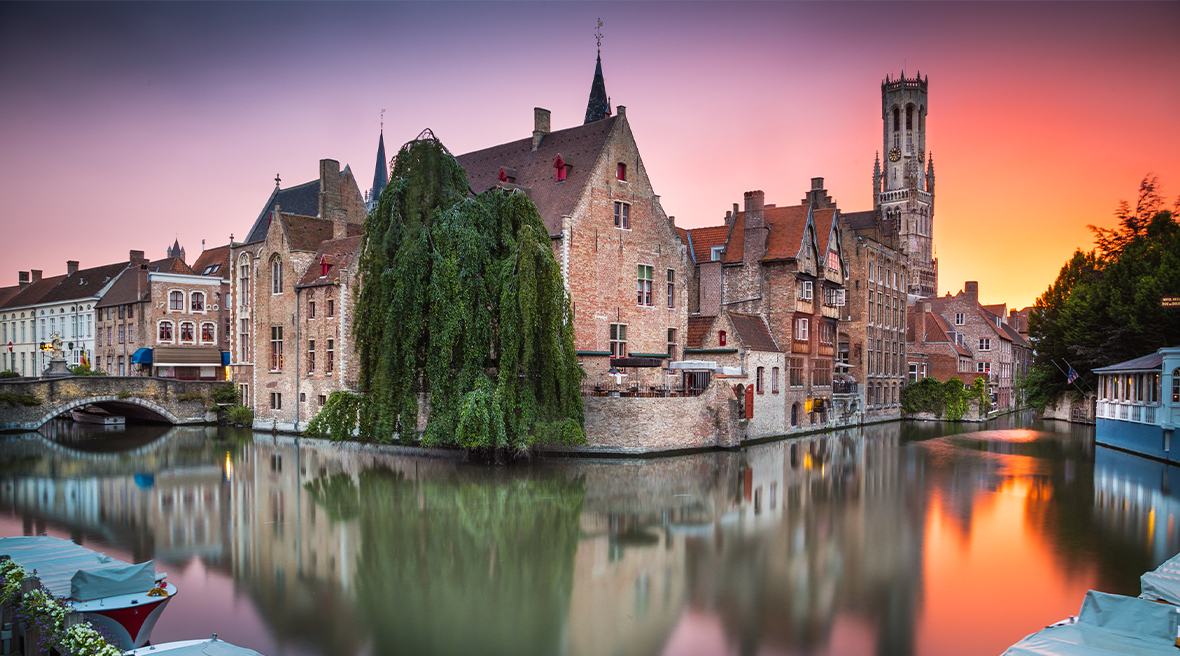
Bruges – ‘an outstanding example of a medieval historic settlement’ (UNESCO)
The winding canals and cobbled streets of Bruges is Belgium at its most picturesque, but that is not the only reason that the port city in West Flanders is UNESCO protected. In the Middle Ages Bruges was one of Europe’s economic hubs, and the architecture this wealth produced illustrates how the city developed.
Bruges was also a centre of artistic patronage and painting, nurturing the likes of Jan Van Eyck and Hans Memling, leading artists of the so-called ‘Flemish Primitives’ in the 15th and 16th centuries.
Bruges is less than two hour’s drive from the LeShuttle terminal, so would make an ideal first stop on your UNESCO tour of Belgium!
La Grand-Place, Brussels
UNESCO calls the Grand-Place an ‘architectural jewel’, and it would be hard to disagree. The main square in Brussels is one of the greatest in Europe, if not the world. It is all the more stunning because most of the buildings are replicas of the original medieval square, almost completely destroyed by war in 1695.
The Grand-Place is notable for its combination of Gothic and Baroque styles and for the fact that this is a square without a religious building – from the City Hall to the King’s House, it is a mix of municipal buildings, private residences and the buildings of city corporations and guilds. Now full of shops, bars, restaurants and museums (including the chocolate museum!) the Grand Place is the main landmark of Brussels and the place to go for a coffee, beer or spot of lunch or dinner.
Notre-Dame Cathedral in Tournai
Tournai is another Belgian city within easy driving distance of Calais, and the cathedral is well worth a hop across the border to see. It impressed UNESCO because of the way it is a peak expression of Romanesque and early Gothic styles of architecture. Among the things to look out for is the large Romanesque nave, the Gothic choir, the ornate carvings on the exterior and the transept with its five bell towers, perhaps the cathedral’s most distinctive feature.
Germany
How many heritage sites are there in Germany?
There are 51 UNESCO World Heritage Sites in Germany.
Cologne Cathedral
Cologne Cathedral is the largest Gothic church in Northern Europe, and the focal point of one of Germany’s largest cities.
The cathedral is the country’s most visited landmark, with over 20,000 people exploring the church every day. With its two towering spires and gothic design, it's a truly magnificent architectural wonder. Inside, you can admire the sky-high ceilings, and stained glass windows; one of which was created by artist Gerhard Richter, and looks as if it’s been made of multi-coloured confetti.
The church is also home to plenty of treasures and iconic sculptures, including the Shrine of the Three Kings and the Crucifix of Bishop Gero.
Bergpark Wilhelmshöhe
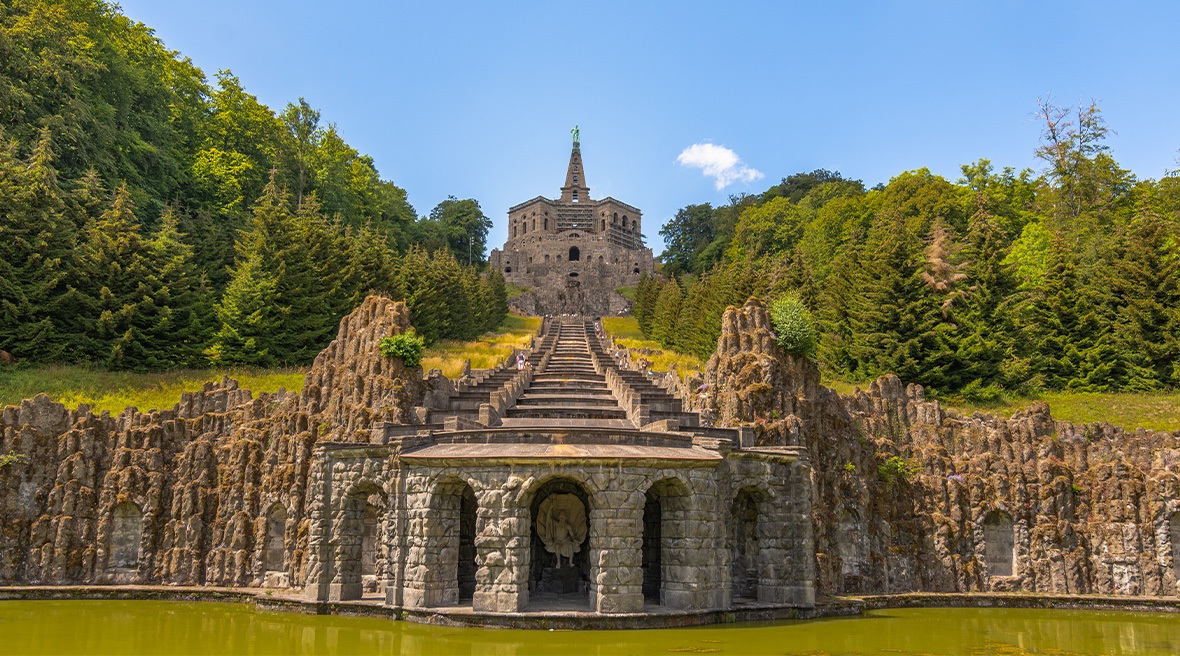
Bergpark Wilhelmshöhe is Europe’s largest hillside park
This landscaped park is located at the foot of the Habichtswald mountain range in Hesse, Germany and covers 590 acres with vast beauty and unique features. The park was the idea of the Landgraves of Hesse-Kassel. Construction of the park began in 1696, and took 150 years to complete.
Bergpark Wilhelmshöhe is known for its amazing sculptures and water features, with one of its most famous being the Hercules monument, a bronze sculpture of the Greek legend standing proudly at the top of the hill. There are stunning views of the city of Kassel from the top, framed beautifully by trees. Running water cascades down the hillside over a series of steps to the lake in front of Schloss Wilhelmshöhe.
Visit Europe’s most important sites with LeShuttle
Many of these World Heritage Sites are within a few hours drive of the LeShuttle terminal. So whether you find inspiration in buildings, feats of engineering or natural wonders, the first step on your journey of discovery is a 35 minute crossing from Folkestone.